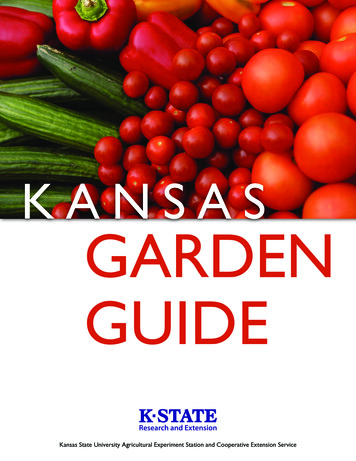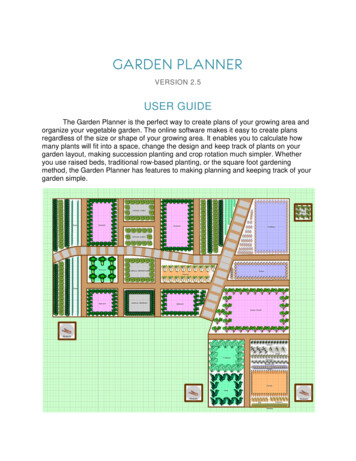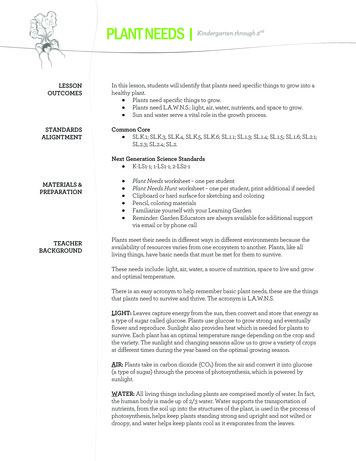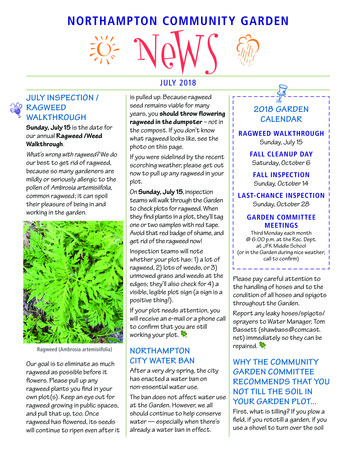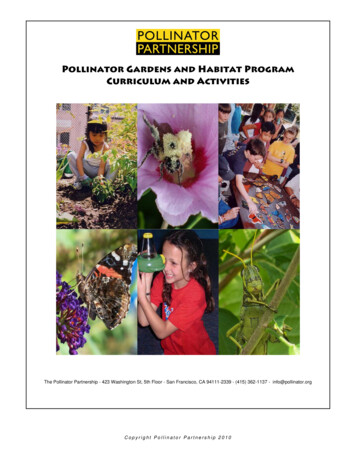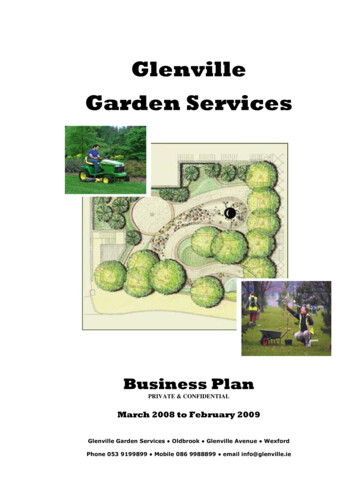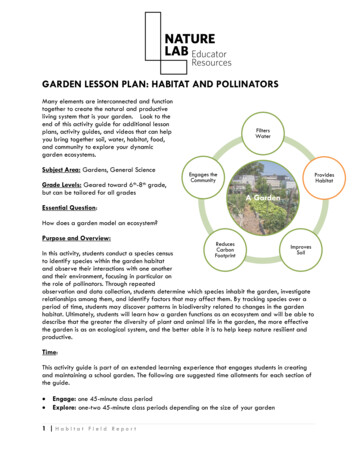
Transcription
GARDEN LESSON PLAN: HABITAT AND POLLINATORSMany elements are interconnected and functiontogether to create the natural and productiveliving system that is your garden. Look to theend of this activity guide for additional lessonplans, activity guides, and videos that can helpyou bring together soil, water, habitat, food,and community to explore your dynamicgarden ecosystems.Subject Area: Gardens, General ScienceGrade Levels: Geared toward 6th-8th grade,but can be tailored for all gradesFiltersWaterEngages theCommunityProvidesHabitatA GardenEssential Question:How does a garden model an ecosystem?Purpose and Overview:ReducesCarbonFootprintImprovesSoilIn this activity, students conduct a species censusto identify species within the garden habitatand observe their interactions with one anotherand their environment, focusing in particular onthe role of pollinators. Through repeatedobservation and data collection, students determine which species inhabit the garden, investigaterelationships among them, and identify factors that may affect them. By tracking species over aperiod of time, students may discover patterns in biodiversity related to changes in the gardenhabitat. Ultimately, students will learn how a garden functions as an ecosystem and will be able todescribe that the greater the diversity of plant and animal life in the garden, the more effectivethe garden is as an ecological system, and the better able it is to help keep nature resilient andproductive.Time:This activity guide is part of an extended learning experience that engages students in creatingand maintaining a school garden. The following are suggested time allotments for each section ofthe guide. Engage: one 45-minute class periodExplore: one-two 45-minute class periods depending on the size of your garden1 Habitat Field Report
Explain: two to four weeks for data collectionEvaluate: one 45-minute class periodExtend: allow at least one 45-minute for each of the activities suggested in this section of theguideMaterials and Resources:Materials for teacher: Computer with Internet connection Dry/Erase whiteboard with stand (optional)Materials for each student or group of students: Garden Project Notebook and pencils Computer with Internet connection Digital camera or mobile device for taking photos Access to printed and online field guides, such as:o Beneficial Insects, Spiders, and Other Mini-Creatures in Your Garden https://pubs.wsu.edu/ItemDetail.aspx?ProductID 15656&ReturnTo 6o Petersen or Audubon guideso The Cornell Lab of Ornithology - All About Birds - https://www.allaboutbirds.org/o BugGuide - https://bugguide.net/o eNature.com Field Guides .com/fieldguides/ Handouts listed below can be found es/activity-guide-habitat/a. Habitat Field Reportb. Habitat Data Analysisc. Habitat EvaluationNature Lab videos supporting this activity guide: Pollinators – Putting Food on the Table https://vimeo.com/77811127 Global Gardens - https://vimeo.com/77792707 Coral Reefs – Feeding and Protecting Us - https://vimeo.com/77811130Gardens How-to Video Series: Planning Your Garden - https://vimeo.com/91446626 Building a Garden in a Day - https://vimeo.com/91445078 Caring for Your Garden - https://vimeo.com/92520693 Fears in the Garden - https://vimeo.com/92531513Objectives:The student will Knowledge Define the concept of a habitat. Define the concept of species within a habitat. Define the concept of biodiversity.2 Garden Lesson Plan: Habitat and Pollinators
Understand how biotic and abiotic factors interact as a system within a habitat.Review the process of pollination and the role of pollinators within a habitat.Comprehension Observe and identify species found in the garden. Describe plant characteristics that tend to attract one type/species of pollinator.Application Identify, record, and estimate the number of species present in the garden habitat duringregular intervals of time. Identify plants with characteristics that are most likely to attract one type/species ofpollinator.Analysis Describe the relationship between habitat and biodiversity in the garden. Describe the effects of pollinator behaviors in the garden habitat. Develop an argument that specific plants will provide habitat and food for a specifictype/species of pollinator.Synthesis Generate ideas and list factors that may affect biodiversity. Review habitat data and garden design to determine which factors impact the degree ofbiodiversity present over time. Develop a theory for how biodiversity makes nature resilient and productive.Evaluation Judge the effectiveness of the school garden to support biodiversity. Evaluate if and/or how the garden can support greater biodiversity. Evaluate how a garden models an ecosystem. Evaluate how greater biodiversity of flowering plants affects the biodiversity ofpollinators in the garden.Next Generation Science Standards:Disciplinary Core Ideas: LS1.B Growth and Development of Organisms LS2.A Interdependent Relationships in Ecosystems LS2.B Cycle of Matter and Energy Transfer in EcosystemsCrosscutting Concepts: Cause and Effect Patterns Energy and Matter Stability and ChangeScience and Engineering Practices: Planning and Carrying Out Investigations Analyzing and Interpreting Data Using Mathematics and Computational Thinking3 Garden Lesson Plan: Habitat and Pollinators
Performance Expectations:Middle SchoolActivities in this lesson can help support achievement of these Performance Expectations: LS1-4 Use argument based on empirical evidence and scientific reasoning to support an explanation for howcharacteristic animal behaviors and specialized plant structures affect the probability of successfulreproduction of animals and plants respectively. LS1-5 Construct a scientific explanation based on evidence for how environmental and genetic factorsinfluence the growth of organisms. LS2-1. Analyze and interpret data to provide evidence for the effects of resource availability on organismsand populations of organisms in an ecosystem. LS2-2 Construct an explanation that predicts patterns of interactions among organisms across multipleecosystems. LS2-3 Develop a model to describe the cycling of matter and flow of energy among living and nonlivingparts of an ecosystem. LS2-4. Construct an argument supported by empirical evidence that changes to physical or biologicalcomponents of an ecosystem affect populations.Common Core Standards:6th-8th Grade Science and Technical Subjects CCSS.ELA-Literacy.RST.6-8.3 Follow precisely a multi-step procedure when carrying out experiments, takingmeasurements, or performing technical tasks.Vocabulary:Abiotic: The non-living elements (sunlight, water, rocks, etc.) that are a part of and interact withbiotic factors in an ecosystem.Biodiversity (short for “biological diversity”): The variety and quantity of life found in a givenenvironment. Generally, the greater the biodiversity found within an ecosystem, the healthierthe ecosystem.Biotic: The living organisms found within an ecosystem.Citizen Scientists: Volunteers who collaborate with scientists on research projects, especially thoseinvolving scientific data collection.Habitat: The natural home or environment of an animal, plant, or other organism.Invasive Species: A non-native species whose presence in an ecosystem causes environmental,ecological, or economic harm.Monoculture: The cultivation or growth of a single crop or organism, especially on agricultural orforest land.Organism: An individual form of life such as a single plant, animal, bacterium, or fungus.Pollination: The transfer of pollen from the male anther to the female stigma of a plant.Pollinator: The agent (living or non-living) that moves pollen from the male anther to the femalestigma of a plant.Species: A group of animals or plants that are similar and can reproduce; smaller than genus.4 Garden Lesson Plan: Habitat and Pollinators
Species Census: A systematic count of the species and members of each species observed withina specified area or from a specified location.Stressors: A chemical or biological agent, environmental condition, external stimulus, or event thatcauses stress to an organism.Taxonomy: The science of defining groups of organisms on the basis of shared characteristics andgiving names to those groups.Engage1. Have students create a list of organisms they have noticed in the garden.2. Discuss the lists with students. Possible discussion points include: Why do you think you’ve seen these organisms in the garden? Is there a scientific explanation for their presence? Which came first, the animals or the garden?3. Explain that the garden is not only a home for plants but also a habitat for animals, a habitatthat students have helped to create but which ecological processes, including the presence ofbiotic (living) and abiotic (non-living) factors, work to sustain.4. Students will conduct a habitat survey in the garden to find out what species are part of thishabitat and how they interact with one another and the garden environment.5. Types of data to be collected:a. Class and Date: If there are several classes participating in your school’s garden project,choose the appropriate class name and enter the date on which your students made theirobservations.b. Quantity: For each animal that students observe, how many do they see?c. Organism: Type in the animal’s common name — for example, earthworm, honey bee,lady bug, ruby-throated hummingbird, chipmunk.d. Type: What kind of animal is it? The drop-down menu includes both specific types — bee,beetle, butterfly, dragonfly, grasshopper, moth — and general types — other insect, bird,mammal, other organism, etc.e. Notes: Use this text box to add your students’ observations on where they saw the animaland its behavior.f. Photos: Explain that you will be able to upload the students’ photos of animals theyobserve in the garden. Determine the most suitable method for the students to give you thephotos.6. As a discussion or writing prompt, ask students:What is the benefit of having lots of different kinds of organisms (biodiversity) in a habitatlike the garden? Why is more biodiversity generally preferable in regard to the health of anecosystem?5 Garden Lesson Plan: Habitat and Pollinators
a. To prompt students, remind them of what they have learned about food webs and foodchains. What can happen if a species disappears from a food web? (The plants and/oranimals that the missing species feed on may multiply and disturb the balance of theecosystem, while the animals that feed on the missing species may also disappear,disturbing the ecological balance further.) By contrast, what happens when there are manydifferent species in the food web? (More species increases the number of potential foodsources for other animals in the food web, particularly if there are more species at everylevel of the food chain, and makes the ecosystem more resilient and adaptable tofluctuations in the population of any one species.)b. Remind students also of the role certain animals play in the ecology of the garden. Ask:Why would we want lots of different kinds of bees and wasps and butterflies? Studentsshould recall (from the Living Systems activity guide) that these animals are pollinators thatplay a crucial role in plant reproduction. The more diverse kinds of pollinators there are,the more likely the plants will be pollinated, since species are attracted to different typesof plants.c. Also ask students to think about how biodiversity can keep an ecosystem healthy,productive, and strong. Why would an array of plants and animals in any habitat keepthat habitat healthy and strong? To illustrate this point, ask students to think about amonoculture — the cultivation or growth of a single crop or organism — such as a cornfield. In a monoculture, only one type of plant is produced. What happens if a pest ordisease attacks this monoculture? If the pest or disease is strong enough, the entiremonoculture, a field of corn in our example, can be wiped out. When a habitat or livingsystem is diverse, however, that habitat is composed of many species and is therefore ableto withstand attack from pests or disease. In our example, if the singles species (corn) iswiped out, the entire habitat suffers, whereas a habitat that is composed of manydifferent types of plants, including corn, can survive an attack by pests or disease – Thecorn may be gone, but the system isn’t composed entirely of corn, so the system (thehabitat) itself remains alive.7. Conclude by returning to your list of animals that students have noticed in the garden. Countthe different species represented on the list, and then ask students to forecast how many morespecies they will find when they begin to observe the garden systematically. Reach aconsensus and set this number as a hypothesis for your species census.ExploreData Collection Preparations1. Explain to students that they will be gathering data on animals in the garden by conducting aspecies census. This means they will be looking very closely and carefully at every part of thegarden, taking notes on the different animals they see, and counting how many they see ofeach different kind.NOTE: At this point, you should ask if any students know they are allergic to bee stings andtake appropriate precautions to keep those studentssafe.6 Garden Lesson Plan: Habitat and Pollinators
2. Tell students that by conducting a species census they will be practicing important skills thatscientists use to study biodiversity. By identifying and counting the animals in a specific habitat,scientists monitor species populations to determine if stressors – such as drought, competitionfrom other species, or pollution - are threatening a species. It’s this kind of scientific field workthat enables scientists to identify endangered species, like the Giant Panda in China and theIsland Fox in California and take steps to protect them. Scientists often get data fromvolunteers when they conduct a species census, and it could be that someday a scientist willtake data from the students’ species census to study the effect of school gardens onbiodiversity. In this way, students may eventually contribute to the work of what are called“citizen scientists” — ordinary people who collect data to help scientists with research.3. To prepare students for their species census, distribute copies of the Habitat Field Report, orcreate your own in a garden journal, and review how students will use this chart to recorddata on organisms in the garden. Point out that students will be collecting other kinds of datain addition to the data they will be reporting could be:a. Organism: Write in the common name of the animal you observe. If you don’t know thename, leave this space blank and take a photo of the animal or describe it in the Notescolumn. You can look up the name later in a field guide.b. Quantity: Keep a count for each different animal. For example, if you see an earthworm,write down 1; then, if you see another earthworm, change your number to 2. Try not tocount the same animal twice. Some animals are hard to count, like ants. If you can’t countall the animals, make a guess or write “lots.”c. Type: Use the code at the bottom of the chart to identify the type of animal you haveobserved. These are the same types listed on the website.d. Where Observed: Describe where you observed the animal. Try to include both thegeneral location (for example, “in the tomato patch” or “in the shade of the maple tree”)and exactly where the animal was when you saw it (for example, “crawling on a stem” or“sitting on the bark of the tree trunk”).e. Role: Some animals play a special role in the garden’s ecology. Use the code at thebottom of the chart when you observe an animal that plays one of these roles: Pollinators are animals that spread pollen by flying from flower to flower or bycrawling into and out of different flowers. Many pollinators are insects, but manybirds, such as hummingbirds, can pollinate plants as well. Decomposers, usually found in or on the soil, are animals that feed on and help breakdown decayed organic matter. They play an integral role in the health andproductivity of the garden. Worms are an example of decomposers in the garden. Invasive species are non-native organisms that are usually introduced to an ecosystemor habitat from an external source and can play a harmful role in the ecology of thegarden. Invasive species can be plants or animals and may disrupt an ecosystem bydominating a region or particular habitat because of the loss of natural controls(predators or other factors in an ecosystem that keep populations of species in check).When introduced to a new ecosystem or non-native habitat, an invasive species canquickly multiply and dominate, negatively impacting native species, because theirpopulation is no longer controlled by predators or other factors. The Japanese Beetleis an example of an invasive species – the beetle was brought to North America7 Garden Lesson Plan: Habitat and Pollinators
around 100 years ago, where it has no natural controls, and is a serious pest for about200 species of native plants, including rose bushes, grapes and many species of trees.Pests also play a harmful role in the garden ecology, but mainly from the gardener’spoint of view. Aphids and scale insects, for example, which feed on plant sap, can beconsidered pests when they become so numerous that they weaken or kill a plant.Moles, which burrow through the soil and feed on earthworms, may be consideredpests if their burrows disturb plant roots and slow their growth. Gardeners need to beaware of pests like these, so they can protect their plants, and students can categorizean animal as a pest if it seems to be damaging a plant.Note that students may not yet be able to identify the role of all the organisms theysee in the garden. Let them know that if they make detailed notes of the organism’sbehavior and appearance, they will later be able to do research to learn more abouteach organism.f. Notes: Students will use this space to describe organisms they will need to identify laterand to take notes on animal behaviors — both how the animal interacts with the gardenenvironment (for example, flying from flower to flower on a specific plant, hiding under aleaf, perching on a garden sign) and how it interacts with other animals (for example,attacking or eating another animal, running to hide from another animal). As they makethese observations, students can evaluate how the animal’s behavior fits into the gardenecology and what role the animal plays.4. After you have reviewed the field report chart, take students online to become familiar withsome of the field guides available for identifying animals they observe in the garden.Demonstrate how to use these guides by having students name or describe animals theyalready know to learn how these sites’ search engines work.a. Beneficial Insects, Spiders, and Other Mini-Creatures in Your Garden This online guide,available as a pdf, provides information about how to attract and keep beneficial smallorganisms in your garden.b. The Cornell Lab of Ornithology - All About Birds website provides a searchable Bird Guidethat is helpful if you know a bird’s general name — for example, you think the bird is asparrow but don’t know what kind of sparrow. There is also a shape guide(www.allaboutbirds.org/guide/browse/shape) that is useful if you know what a bird lookslike but don’t know what it is. In addition, for students with smartphones, there is a freebird identification app, Merlin Bird ID that asks a few questions about the bird you areobserving — size, color, etc. — and then shows pictures of birds that fit your description.c. BugGuide also provides a shape guide on the website’s homepage and a search box atthe upper right corner of the homepage where students can type in an insect name andsee pictures of all kinds of insects that have that name — just click a picture to learn more.The BugGuide includes information about insects, arachnids (spiders, etc.), and myriapods(centipedes, etc.).d. eNature.com (still available via Internet Archive) offers field guides on many differentkinds of animals — birds, mammals, reptiles, amphibians, butterflies, other insects, andspiders (plus trees, flowers, and other plants). The site also has a search page wherestudents can select the type of animal they are trying to identify, answer a few questionsabout the animal’s shape, size, and color, and see pictures of animals that fit theirdescription.8 Garden Lesson Plan: Habitat and Pollinators
5. As you explore field guide sites, you will find that most include catalogs that organizeinformation on different animals based on taxonomy. This is the system that scientists use toidentify and classify all living things, not just animals, based on similarities in their appearance,anatomy, and other factors. Taxonomy groups similar animals into smaller and smaller subsets,all the way down to individual species. It’s a system that was developed in the 18th century byCarl Linnaeus, who introduced the practice of giving organisms “scientific names.” These areusually Latin names composed of two parts, the genus name and the species name. Forexample, the scientific name for a robin is Turdus migratorius, which means that it belongs tothe Turdus genus of birds and has the species name migratorius. Scientific names usually tellyou something about the animal: turdus means “thrush” in Latin and migratorius means “tomigrate,” so this scientific name tells you that a robin is a migratory thrush. Students will findscientific names for every organism they identify with a field guide and can use these guidesto learn the scientific names for organisms they may already know — like the robin. Withpractice, students may also learn to use the scientific catalogs on these sites to distinguishdifferent species of organisms that look very similar and to search for organisms based ontheir scientific classification.6. Finally, to prepare students for what they might encounter during your species census, show theFears in the Garden video to help students address any fears they may have about the speciescensus. Follow up by emphasizing that students should be extra cautious about observing beesand other stinging insects up close.Collecting Data in the Garden1. Schedule a day to begin your species census and plan the intervals you will use to collect dataover time. Plan also to have students return to the garden as seasons change throughout theschool year to gather new data that may reveal changes in the habitat’s species populationdue to longer term environmental factors like trends in rain fall, weather, seasons, etc.2. Organize students into pairs or small groups for your species census. If possible, each pair orgroup should have a digital camera or mobile device to photograph the species they observe.3. Assign each student pair or group to a specific location or area within the garden. Explainthat dividing the garden space in this way will help them look closely at every part of thehabitat and make it less likely that they count a particular animal twice. Students can stick withtheir location assignments as you continue the census, or you can focus their observations indifferent ways: for example, have each pair search for and count organisms in a differentsquare foot of soil; have them observe and count organisms on different plants; or positionthem around the garden perimeter to observe only organisms that enter and leave thegarden. You can provide students with hula hoops to lay down and have them only count thespecies inside the hoop.Alternatively, your students can use transects and quadrats in the garden to mirror the wayscientists might collect data in the field. This process will probably work best if you arefocusing on insects and bugs since larger animals will be scared away. There are a variety ofonline resources to instruct you how to use this process. COSEE West has a lesson plandedicated to using quadrats and transects in the ttp://www.usc.edu/org/coseewest/Dec2012/Activities and lessons/quadrat transects.pdf) that you can reference.9 Garden Lesson Plan: Habitat and Pollinators
To set-up transects in the garden, have student groups use tapemeasures, yarn, or another measuring device to mark outdistances in the garden. Depending on the size the area,determine what interval makes the most sense. For example,students could lay the measuring tape and mark off every fivefeet with some kind of marker. If you are using quadrats, theycan lay the quadrats bottom left corner at the mark (it doesn’tmatter where they lay the quadrat, but it must be consistent everytime). Quadrats can be as large or small as makes sense for yourspace. If you are using quadrats made of PVC pipe like in thepicture to the right, students must be careful not to injure plantswhen they place them. Alternatively, students can mark outpermanent quadrats using string that they can come back to everytime they collect data. This might take more time to set-up but willmake data collection quicker during subsequent collection periods.4. Remind students that they are scientific observers and should notinterfere with the animals they observe. No poking, teasing,grabbing, or swatting. Encourage students to show care for thegarden and its inhabitants and let them know that scientists try tohave the least possible impact on what they are observing so asnot to interfere with the data and results of the data.A scientist using a tape measure tomake a transect in order to place aquadrat at specific intervals for abiodiversity study.Photo credit: Britta Culbertson5. Give students a set amount of time to observe organisms within their assigned area ortransect. They will likely see many organisms within a 10-minute period. They should use thistime to observe and record organisms, their behavior, any characteristics that may be usefulfor identification, and any other information that seems notable.6. Move among the student pairs to help them correctly fill in their Field Report charts. Explainthat it is important that all students keep a detailed and complete record of what theyobserve – the more consistent and detailed you are in the data you collect, the morescientifically accurate and meaningful the data is. If you collect your data in a consistent way,you can then compare this data across time periods and to other data you have collectedabout your garden.7. After each observation period, set aside time to work with students to identify any organismsthey don’t know and compile their data. Total up the number of organisms they observed —how many crickets, how many sparrows, butterflies, etc. — and select photos of each speciesto upload with your data. Have students share their notes on each species in a class discussionand help them pull details from these different observations to compose a class note on thatspecies for your data report.8. To help students assess biodiversity in the garden, have them also conducted a test speciescensus in another natural area on the school campus. They will later compare the number ofdifferent species they observed at this test site with the numbers they observed in the garden.If their test site is a lawn or less diverse ecological area, they may find evidence that a widerdiversity of plants, as in the garden, provides habitat for a wider diversity of organisms.10 G a r d e n L e s s o n P l a n : H a b i t a t a n d P o l l i n a t o r s
9. Students can use data collected on other elements of the garden like rainfall and waterfiltration to make hypotheses about how different elements of the garden affect one another.Possible questions for students: Do you see more or fewer species in the garden when it has rained? Are you experiencing an extended drought period? How does this affect the species, in diversity and quantity, in the garden?Explain: Data Analysis1. Distribute the Habitat Data Analysis student handout. Have students work in their groups toanalyze the data they have collected to learn more about the animals that live in the gardenhabitat.2. Have groups present their data, keeping a general running tally on the board of differentspecies and numbers. Have students use their observation notes to describe how the differentanimals and plants in the garden each contribute to the different ecological functions theyhave investigated — water filtration, food production, carbon cycling, and soil health. Helpstudents recognize that the greater the variety of plants in a habitat, the greater the varietyof animal species that are supported by it and the more productive it becomes in performingthe functions of a living system.3. Discuss how such diversity makes the garden habitat more adaptable and resilient, becausethe health of the ecosystem does not depend on the health of one or two plants and theanimals they attract. Ask students to imagine scenarios in which a pest or disease or severeweather conditions (stressors) weaken or kill the plants in a non-diverse habitat such as a fieldof corn, an orange grove, or a rose garden (monocultures). What would happen in theseecosystems? Then have students use their species observations to suggest ways you mightincrease plant diversity within the garden, to create environments for more species.4. For the ecological pyramid, you may want to display a large-scale blank version on the boardor poster paper that students can add sticky notes to, each with the name of a species theyfound that they think belongs at a given level. (For an interactive introduction to ecologicalpyramids, visit Virtual Lab: Model Ecosystems athttp://www.mhhe.com/biosci/genbi
biotic (living) and abiotic (non-living) factors, work to sustain. 4. Students will conduct a habitat survey in the garden to find out what species are part of this habitat and how they interact with one another and the garden e



